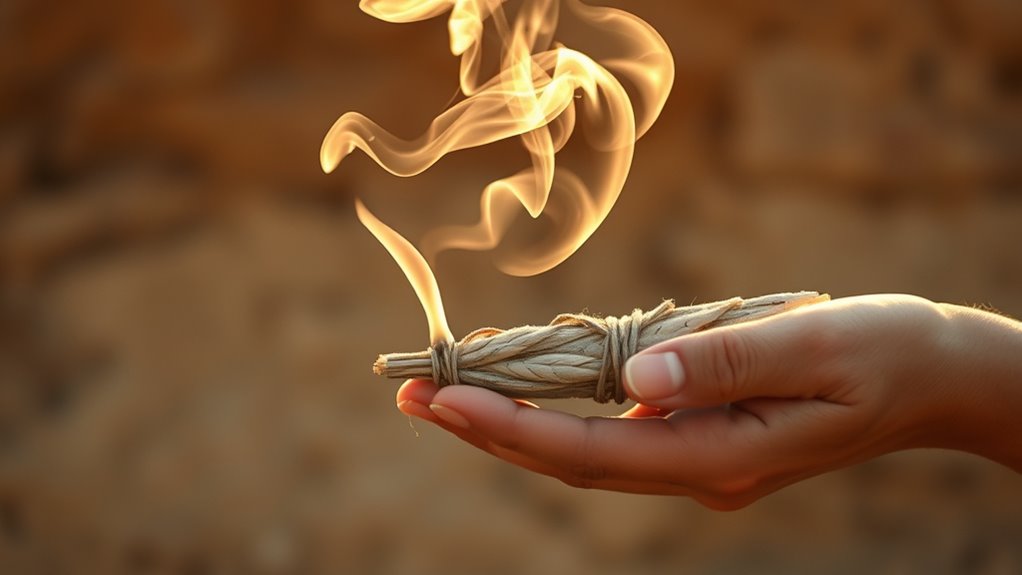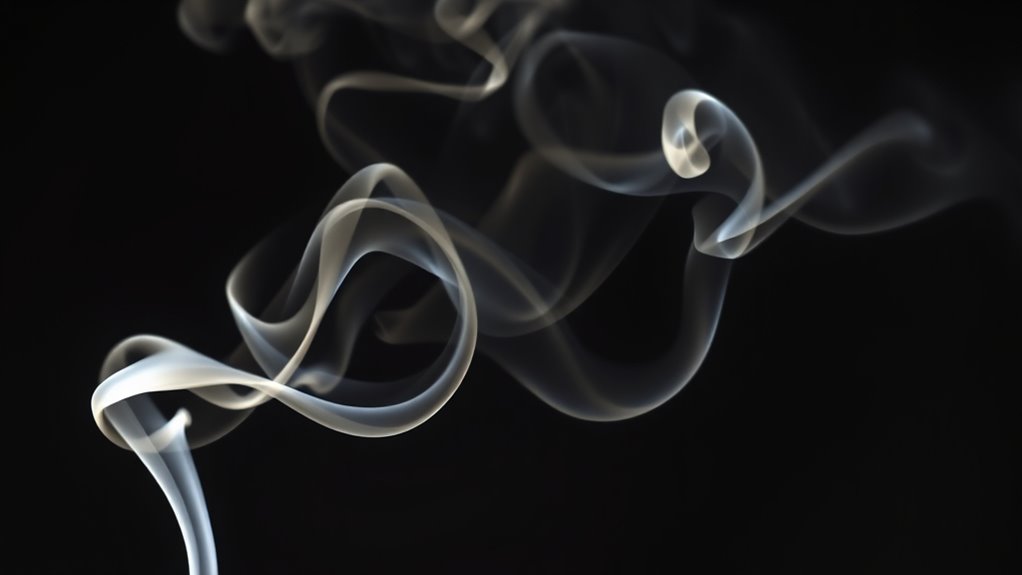Smudging is a meaningful spiritual practice that involves burning sacred herbs like sage, cedar, or sweetgrass to cleanse negative energies and invite positive vibes. It connects you to cultural traditions, ancestors, and natural energies through rituals, chants, and intentions. This act helps create a sacred space for reflection, healing, and renewal. If you want to understand more about the symbolism and deep significance behind smudging, there’s much more to explore beyond this overview.
Key Takeaways
- Smudging is a spiritual practice rooted in cultural traditions that involves burning sacred herbs to cleanse negative energies.
- The herbs used, like sage, cedar, and sweetgrass, carry symbolic meanings such as purification, protection, and inviting positive energy.
- The ritual combines intentional gestures, prayers, and timing to create a sacred space for reflection, healing, and spiritual connection.
- It fosters emotional well-being, helping individuals feel centered, calm, and connected to their cultural identity and ancestors.
- Approached with respect and authenticity, smudging remains a meaningful practice for personal renewal and cultural preservation.

Have you ever wondered why smudging has been practiced for centuries across different cultures? It’s more than just a ritual; it’s a powerful tradition rooted in spiritual beliefs and cultural identity. When you engage in smudging, you participate in a ceremonial tradition that has been passed down through generations. These ceremonies often involve specific practices, chants, or prayers, emphasizing respect and reverence for the process. The act of burning sacred herbs like sage, cedar, or sweetgrass isn’t random—it’s deeply symbolic and meaningful, serving to connect you with spiritual realms, ancestors, or natural energies. The herbal properties of these plants are believed to carry specific qualities that aid in purification, protection, and healing. For example, sage is renowned for its cleansing abilities, helping to clear negative energies, while cedar is thought to invite protection and grounding. Sweetgrass, often used to invite positive energy and blessings, completes the trio of herbs frequently employed in smudging rituals. These herbal properties aren’t just mystical notions; they’re rooted in centuries of tradition and observation, emphasizing the plants’ natural qualities. By understanding this, you realize that smudging is not merely symbolic but also practical, harnessing the natural qualities of plants to facilitate spiritual and emotional well-being.
As you perform a smudging ceremony, you’re engaging in a mindful act that combines ritualistic intent with the natural power of herbs. Lighting the herbs and allowing the smoke to drift around your space or yourself is a way to symbolically release negativity and invite positive energies. The smoke acts as a conduit, carrying intentions and prayers into the universe, creating a sacred space for reflection or renewal. Many cultures see this act as a way to honor spiritual traditions and ancestors, reinforcing cultural identity and connection to the earth. The ceremonial traditions surrounding smudging often include specific gestures, timing, and setting, all designed to deepen the spiritual experience. You might find that the act of smudging helps you feel more centered, calm, or protected, especially when you’re facing stressful situations or seeking clarity. Its significance goes beyond individual well-being; it’s a cultural practice that sustains the spiritual fabric of communities. By respecting its ceremonial traditions and understanding the herbal properties involved, you can approach smudging with genuine reverence, making your practice both meaningful and authentic. This ancient ritual continues to resonate today because it taps into universal themes of cleansing, renewal, and spiritual connection—reminding you of the enduring power of nature and tradition in your personal journey.
Frequently Asked Questions
Can Smudging Be Done Indoors Safely?
Yes, you can smudge indoors safely if you make certain you have proper indoor ventilation and keep smoke alarms in mind. Open windows and doors to let fresh air circulate, reducing smoke buildup. Be cautious with the amount of smudge used to prevent overwhelming smoke. Always monitor your smoke alarms and turn them off if needed, then turn them back on afterward. With these precautions, indoor smudging remains safe and effective.
Are There Health Risks Associated With Smudging?
Yes, there are health risks associated with smudging, especially related to smoke exposure. You should take health precautions like ensuring proper ventilation and limiting the duration of smoke inhalation. If you or others have respiratory issues, it’s best to avoid prolonged exposure or consult a healthcare professional beforehand. Being mindful of smoke dispersion helps protect your respiratory health while still enjoying the spiritual benefits of smudging.
How Long Does the Cleansing Effect Last?
Think of the cleansing effect as a gentle breeze that refreshes your space; its duration of effects varies based on intent and environment. Usually, the cleansing longevity lasts from hours to a few days, depending on how often you perform the ritual and the openness of the space. Remember, the spiritual renewal you seek can be renewed with regular smudging, keeping your environment clear and energized.
Can Smudging Be Performed for Specific Intentions?
Yes, you can perform smudging for specific intentions by engaging in intentional smudging. Focus your mind on your goal or desire as you light the sage or other herbs, directing the smoke toward yourself or your space. Create personalized rituals by setting clear intentions beforehand, speaking affirmations, or visualizing your goals during the process. This purposeful approach enhances the spiritual benefits and aligns the ritual with your specific needs.
Is Smudging Appropriate for All Spiritual or Religious Practices?
Imagine a universal language of light and smoke, weaving through diverse spiritual worlds. Smudging isn’t appropriate for all practices, as cultural appropriateness varies widely; some traditions see it as sacred, others may not recognize it. However, its spiritual universality invites many to experience cleansing and renewal. Respecting each practice’s roots guarantees you honor the tradition’s integrity, allowing the ritual to resonate meaningfully across different spiritual landscapes.
Conclusion
As you embrace smudging, remember it’s more than just burning herbs—it’s a bridge to your inner peace. Like a gentle breeze sweeping away shadows, this sacred practice clears your mind and spirit. Keep the symbolism close to your heart, allowing the smoke to carry away negativity and invite positivity in. With each cleansing, you plant seeds of harmony that blossom within, transforming your space into a sanctuary of serenity and renewal.










